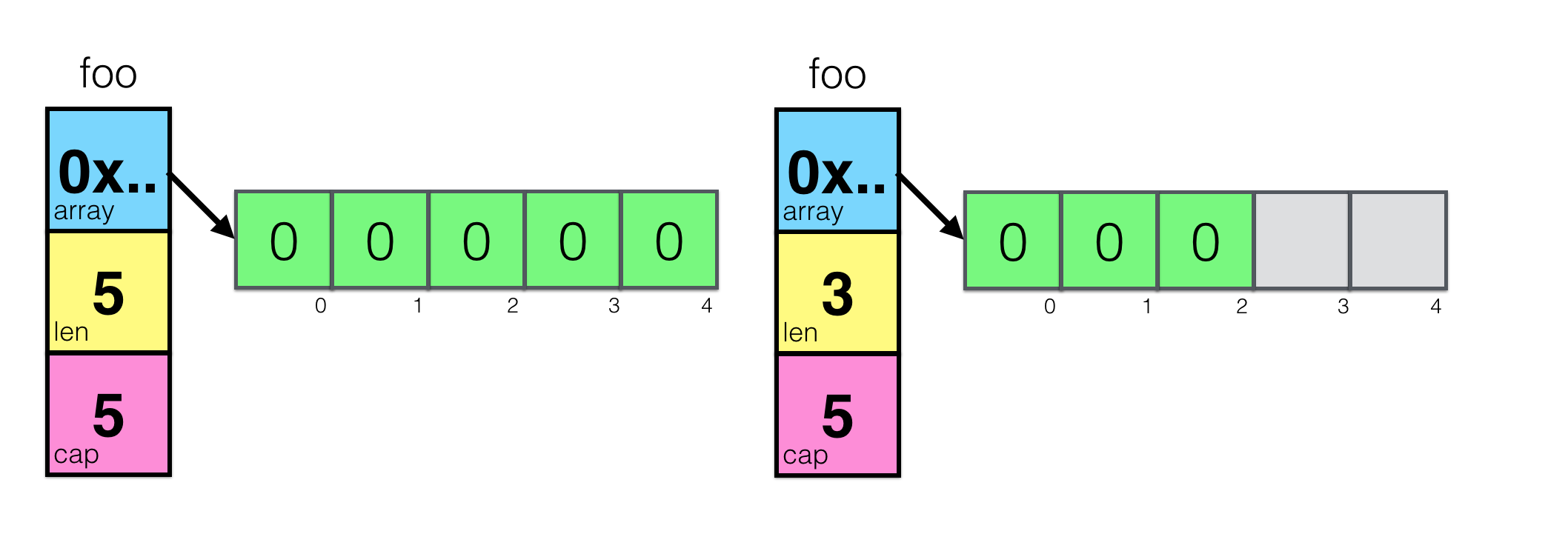关于 Golang Slice 的一些细节
文章目录
【注意】最后更新于 July 9, 2024,文中内容可能已过时,请谨慎使用。
关于 Golang Slice 的一些细节
在 Golang 中,有两种数据类型:
一种是限定长度的数组,叫做 Array,另外一种是不限定长度的数组,叫做 Slice。
区分 Array 和 Slice
Array 和 Slice 的区别在于:
Array 是限定长度的,并且 Array 的长度是类型的一部分,因此 Array 的长度不能改变,而 Slice 可以改变长度。
Slice 是不限定长度的,可以使用 make 函数来创建。
foo = make([]int, 5)
并且 Slice 只是一个数据结构,内部有一个指针,指向数组的首地址,可以使用 len 函数来获取 Slice 的长度,也可以使用 cap 函数来获取 Slice 的容量。
下面会详细的介绍 Slice 的一些实现细节和特性。
Slice 的实现与特性
上文已经提到 Slice 其实是一个数据结构,内部有一个指针,指向数组的首地址。 让我们来先简单看看 Slice 的实现吧:
我们先给出一个简单数据结构,用来演示 Slice 的实现:
|
|
我们可以看到 Slice 的实现是个结构体,其中包含了三个字段: 第一个字段是指向底层数组的指针,第二个字段是 Slice 的长度,第三个字段是 Slice 的容量。 当你初始化一个长度为 5 的 Slice 的时候,他是这样的:
foo = make([]int, 5)
foo = make([]int, 3, 5)

当你初始化一个为 nil 的 Slice 的时候,他是这样的:
var foo []int
|
|
slice header
上文的数据结构中可以看到,Slice 并不是一个真正的数组,而是一个数据结构,它的实现是个结构体,所以当我们在函数间传输 Slice 的时候,其实只是传输了一个 Slice 的 header。所以对于老练的 Gopher 来说,他们在函数间传输和 Channel 间传输的时候经常会提及 slice header。
我们可以讨论一下当 Slice 作为参数传递的时候会发生什么。
|
|
可以发现他运行的输出是:
|
|
可以发现 Slice 作为参数被传递的时候,实际上和传递一个结构体一样,当你使用 append 之后赋给 slice 变量的时候只是把函数拷贝的值改了一下。 从这个例子可以看出,Golang 其实是 copy by value,而不是 copy by reference。当你传入一个结构体的时候,Golang 其实是把这个结构体拷贝了一份。
举一个另外一个例子,来体现 append 的效果以及:
|
|
|
|
可以看出当你在 append 的时候,其实是会修改底层数组。但是我们发现其实如果对数组进行 append 了之后,其实不会对 x 进行修改,因为 x 其实并没有被修改。记住他只是 slice header,他的内容只取决于他的 len,cap 和 array 指针。
Slice 的一些坑
切片的坑
Slice append 的时候,如果超出 cap 的长度,会去尝试 allocate 内存了,是尝试去当前容量两倍的内存,所以操作是非常昂贵的。。其实这个也不是很大的问题,因为 append 结束底层的数组就会被 GC 回收,但是如果有另外的 Slice 引用这个底层数组,就容易出问题。
|
|
Note:顺便说一下,append 只在 1024 以内通过加倍容量来增长分片,之后它将使用所谓的内存大小类来保证增长不超过~ 12.5%。为 32 字节的数组申请 64 字节是可以的,但是如果你的分片是 4GB,为增加一个元素再分配 4GB 是相当昂贵的,所以这是有道理的。
于是我们可以引出: 当你从一个非常大的数组里面尝试读取 3 个字符,会发现其实原始数据仍然是在内存里面
|
|
笋干爆炸💥!!!
string 竟然是 slice?
在 Golang 中,string 只是一串只读的 byte slice,所以你可以直接操作它,但是你不能修改它。
|
|
输出:
|
|
可以发现 string 的长度并不是 2,而是 6,因为 string 包含的是对应的 UTF-8 编码 (因为 Golang 代码是 UTF-8 编码的),同时 string 是一串 byte slice。因为中文每个字符在 unicode 中都对应一个码位,一个码位占用 3 个 byte,所以 string 的长度是 6。
总结
以上就是一些常见的 slice 的使用。
相关阅读
文章作者 xiantang
上次更新 2024-07-09 (9ac8718e)